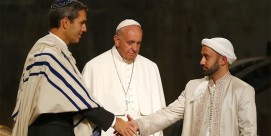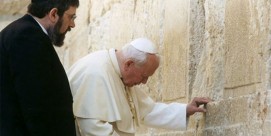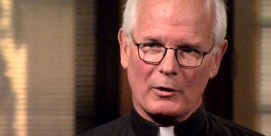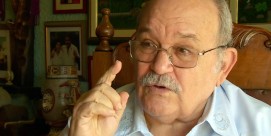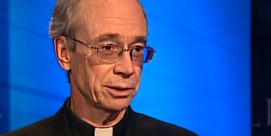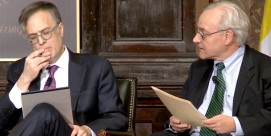In This Episode << SLIDE LEFT TO SEE ADDITIONAL SEGMENTS
Penn State and Clergy Sex Abuse Parallels
DEBORAH POTTER: As the US Conference of Catholic Bishops gathered in Baltimore this week, the group’s president, Archbishop Timothy Dolan, said the sex abuse scandal at Penn State “reopens a wound” for the church. To discuss the parallels, we’re joined by Kevin Eckstrom, editor of Religion News Service, and Kim Lawton, managing editor of Religion & Ethics Newsweekly. Kevin, let me start with you. What are the parallels, as you see them, between what happened at Penn State and the long running sex abuse scandal in the Catholic Church?
KEVIN ECKSTROM (Editor, Religion News Service): Well in both cases you had people who should have known better who made bad decisions and often times the worst part of this whole scandal is not necessarily the abuse, I mean as bad as that is, that’s horrible, but it’s the cover-up that really gets people upset. And you saw that with bishops who would move priests from one place to another and you saw it from people at Penn State who knew what was going on but didn’t report it to the police and kind of, at least from the outside it looks like they tried to keep it quiet.
POTTER: And they moved locations. They allowed Jerry Sandusky to have access to a satellite campus and it’s sort of like the same thing you are mentioning with the priests being just moved even though you know something’s going on. It’s that sort of effort to protect the institution that seems to take over, doesn’t it, Kim?
KIM LAWTON (Managing Editor, Religion & Ethics NewsWeekly): Right and that’s what a lot of people are noticing is this, you know, circle the wagons, protect the institution at the expense of the children. So that was one of the parallels. I think one of the differences though is that the institution at Penn State moved, in a certain sense, belatedly, but they moved to hold some people accountable. And some of the victims’ rights groups that I’ve been talking with this week were frustrated that the church itself hasn’t always seemed to do that. Or, if there were repercussions it comes from the state as we saw in the Kansas situation where it was the state that did the indictment.
POTTER: What do you think the church really has to teach on this subject? Are they in a position to be advising others on how to deal with a sex abuse crisis like this?
ECKSTROM: Well to their credit, the church has actually done a fairly comprehensive study with John Jay College in New York about the roots of the problem, how it developed, how it got worse, how it was ignored. So they do have some sort of statistical data to offer on this is what we’ve learned and these are the steps that we’ve taken to try to prevent this from happening again. So, Archbishop Dolan says, you know, we learned the hard way how this got out of hand and to the extent that we can help other institutions deal with this, you know they’re happy to do it.
LAWTON: It’s interesting because when they first put those new guidelines together in 2002 even back then the bishops were saying they hoped that they could be a model for other institutions and of course, they point out that the church isn’t the only place where sex abuse takes place. And so they’ve been hoping all along they could be a model, but you know, they haven’t always lived up to the guidelines and to the things that they’ve done. And Archbishop Dolan acknowledged that this week and he said we’ve been hesitant to offer advice. He said people in glass houses and all of that. But, indeed, he feels that they do have some resources to offer for how to deal with these situations.
ECKSTROM: Right and the big challenge for the church and for Penn State is it’s one thing to have policies and guidelines, but if you can’t implement them. And that’s been the big problem for the church is getting the bishops or the individual dioceses to implement these policies and if you can’t do that, the policies are sort of meaningless.
LAWTON: I saw somebody this week said that while the church may have some things to teach, the church might also been able to learn some things from Penn State in terms of how they handled it by holding people accountable.
POTTER: And moving quickly to do that at a higher level than it has been the case in the Catholic Church up until now, at least.
LAWTON: Right and you know, also, I think for the church, a lot of people think this is the church. These are people who speak for God, who are God’s representatives on Earth and so in a sense they should be held to maybe a higher standard than Penn State or some other secular institutions.
POTTER: Well although if you talk to some people at Penn State, you know, football is a religion and there are some parallels there in terms of the high regard in which a football coach, for example, might be held. And therefore is in a position of authority and power in order to be able to really manipulate young people.
ECKSTROM: Right. The big difference to remember here though is that Penn State has the ability to fire people.
POTTER: And did.
ECKSTROM: And did. And it’s much harder to do that in the Catholic Church.
POTTER: Thank you both very much.

